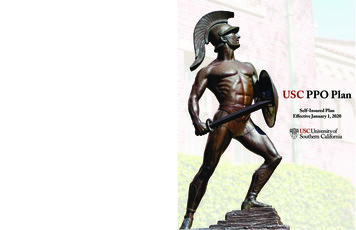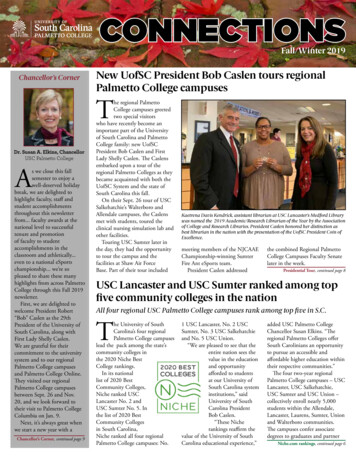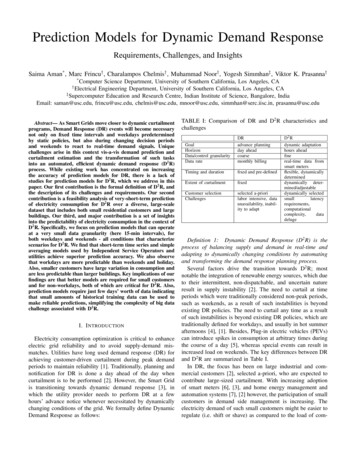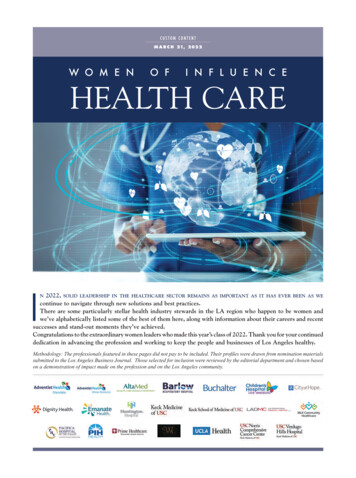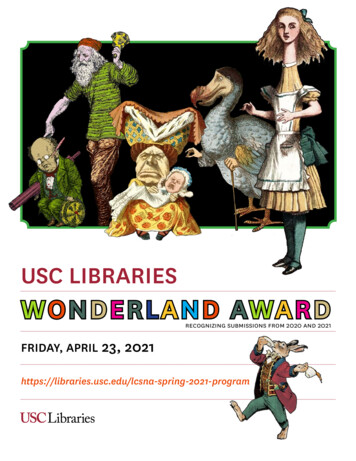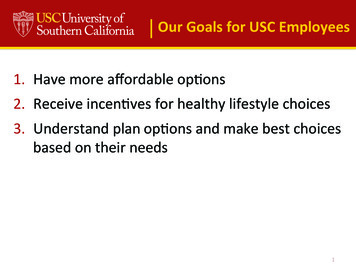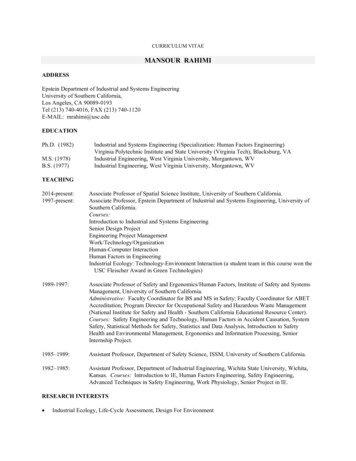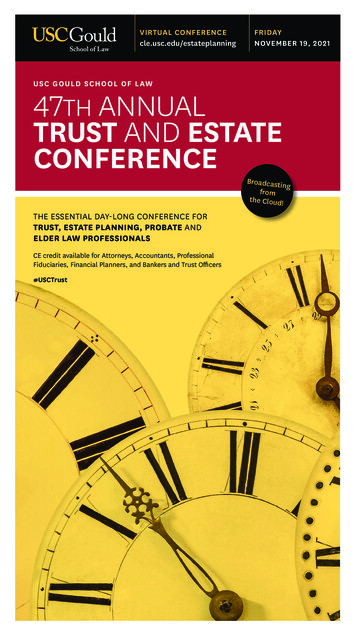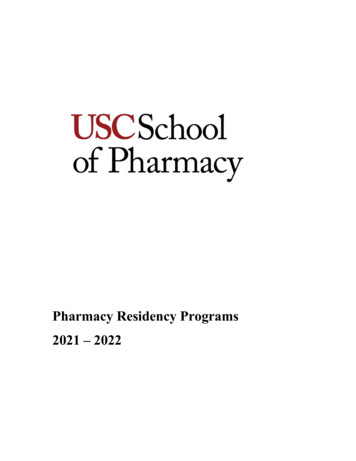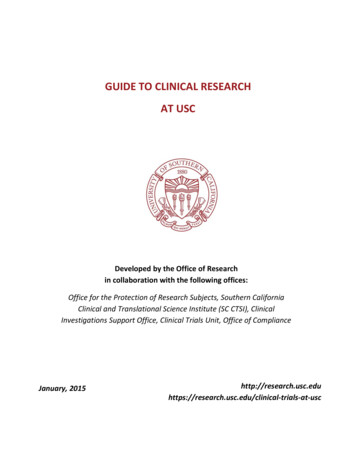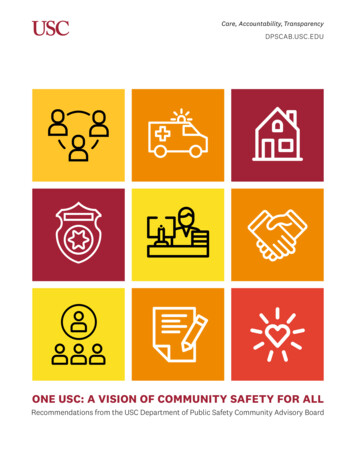
Transcription
Care, Accountability, TransparencyDPSCAB.USC.EDUONE USC: A VISION OF COMMUNITY SAFETY FOR ALLRecommendations from the USC Department of Public Safety Community Advisory Board
ONE USC: A VISION OF COMMUNITY SAFETY FOR ALLRecommendations from the USC Department of Public Safety Community Advisory BoardCare, Accountability, TransparencyDPSCAB.USC.EDU
RUNNING HEADTA B L E O F C O N T E N T S1FROM THE CO-CHAIRS 52EXECUTIVE SUMMARY 93INTRODUCTION 154RECOMMENDATIONS 20General RecommendationsAccountability RecommendationsAlternatives to Armed Response Recommendations 30Community Care Recommendations 36Transparency Recommendations 4044CONCLUDING THOUGHTS AND NEXT STEPS6APPENDIX 1: Comprehensive Recommendations Table 467APPENDIX 2: Legal Analysis 548APPENDIX 3: Data Analysis 639APPENDIX 4: Peer Institution Analysis 7110APPENDIX 5: Calendar of Meetings 7511APPENDIX 6: Methodology 7612APPENDIX 7: List of Documents and Data Reviewed 7713USC DEPARTMENT OF PUBLIC SAFETY (DPS)14DP S COMMUNITY ADVISORY B OARD265220COMMUNITY ADVISORY BOARD (CAB) MEMBERS 2020-2021 79ACKNOWLEDGEMENTS 80
1/FROM THE C0-CHAIRSWe would like to thank President Carol L. Foltfor giving us the honor and privilege of leading theDepartment of Public Safety (DPS) CommunityAdvisory Board (CAB). As CAB co-chairs,we are honored to have been selected to steerthis important effort for the university.The CAB was created to become a crucial factor in ensuring an environment whereeveryone feels safe and respected. We set out to strengthen the trust betweenthe university, DPS and the broader community, particularly in light of recent andongoing events across the country that have underscored the need for transformingthe relationship between law enforcement and the communities they serve. PresidentFolt’s decision that we would report directly to her and the assurance that “nothingwas off the table” illustrated her level of commitment regarding our role, as well asour autonomy.Due in large part to the national urgency of these issues, President Folt taskedthe CAB with undertaking an evidence-based examination of our public safetypractices, including departmental accountability, transparency, bias training andhiring. During the past 10 months the CAB conducted 8 Pilot Conversations,11 Co-Design Public Safety Sessions and 5 Kitchen Cabinet meetings attendedby more than 700 people from across our university community — students,staff and faculty, as well as current and former law enforcement — to ensure ourrecommendations would be informed by a diverse collection of voices. We especiallythank the hundreds of community members, students, staff, faculty, law enforcement,community and university organizations who gave us their time, experiences,expertise and valuable input to support the charge of the CAB during the developmentand deliberations for the recommendations in this report. WhetherDue in large part to the nationalyou met with us individually, sent a message to us through our website,urgency of these issues, Presidentor attended a conversation, co-design session or kitchen cabinetFolt tasked the CAB with undertakingmeeting, we are so grateful for your engagement. Your collectivean evidence-based examination ofcommitment and passion provided constant reinforcement ofour critical role in facilitating a positive relationship between theour public safety practices, includinguniversity and the community. We hope this process will serve asdepartmental accountability,an example of the type of conversations that would prove useful intransparency, bias training and hiring.future efforts to address this important issue.The community’s ongoing engagement during a lingering pandemic and the manyeffects it has generated have been an inspiration, as many returned in phase threeof our work to learn about our preliminary recommendations. We thank those whoparticipated in the Academic Senate, Community Feedback Session, Graduate StudentGovernment, Kitchen Cabinet, President’s Senior Leadership Team, Provost Council,DP S COMMUNITY ADVISORY B OARD5
FROM THE CHAIRSRUNNING HEADStaff Assembly and the Undergraduate Student Government feedback sessions just asclasses were ending for the academic year. Your thoughts and comments, as you willread, are integrated throughout our report. We have deliberately paraphrased or usedquotations that were repeated in similar fashions in a variety of contexts to preservepeople’s confidentiality, but we heard you loud and clear: the need for there to beONE USC experience of community safety equitably distributed to all is something weall need to embrace in the months and years to come.The need for there to beWe certainly could not have accomplished this scope ofONE USC experience of communityengagement without the assistance and support provided bySenior Vice President for University Relations Sam Garrison andsafety equitably distributed to all isExecutive Assistant Alejandro Maldonado. Their extraordinarysomething we all need to embrace inthe months and years to come. administrative, logistical and technical assistance cannot beoverstated. We also want to extend our gratitude to SeniorVice President for Administration David Wright and DPS Chief John Thomas fortheir response to a voluminous data request resulting in more than 600 pages ofdocuments, which helped facilitate the CAB’s deliberations on recommendationsfor the president. We are also appreciative of Executive Director for Public RelationsProjects Eric Abelev and former Communications Coordinator Shannon Ward fortheir innovative creation of our website and timely development and disseminationof communications. Our consultants, 21CP Solutions, were a small but mighty teamof folks from around the country with deep expertise in this area, and we are gratefulto them, particularly but not exclusively for their strong work with each of oursubcommittees.Finally, words will never express our thanks to our fellow CAB members fortheir time and commitment to the process of arriving at consensus around theserecommendations. CAB members brought diverse experiences, expertise andopinions that were extremely useful for the dialogue we had on several sensitiveissues in a respectful and effective manner. They did not complain when weasked for another two-hour meeting, then another the very next Friday, signalinghow seriously we all took our role. All of us remain committed to this area ofcommunity transformation and hope this process will have a meaningful impact onthe enhancement of community safety for all members of the Trojan community:students, faculty, staff and our neighbors.Fight On!Ange-Marie Hancock AlfaroCo-Chair, USC DPS CABDean’s ProfessorChair, Political Science andInternational RelationsUSC Dornsife College of Letters,Arts and Sciences6DP S COMMUNITY ADVISORY B OARDErroll G. SouthersCo-Chair, USC DPS CABProfessor of the PracticeDirector, USC Safe CommunitiesInstituteUSC Price School of Public PolicyDP S COMMUNITY ADVISORY B OARD7
RUNNING HEAD2/EXECUTIVE SUMMARYWhat does safety mean? Who feels safe and whodoesn’t? What are the conditions that producephysical and psychological safety in and aroundthe public spaces of USC?The ONE USC Safety Visionis an environment where:Everyone feels safe,respected and protected frombeing a crime victim. The diverse experiences andneeds of all USC students,faculty, staff and neighborsthroughout USC’s spheres ofinfluence are addressed.The University of Southern California Department of Public Safety (DPS) CommunityAdvisory Board (CAB) has spent the last academic year focusing its attention on two complementary definitions of safety: A safe life that is free from experiencing crime A safe experience navigating the campus and its surrounding locations free of beingfalsely targeted as suspicious, threatening or not belonging to our community.Our work has revealed that we need to have what we have named a ONE USC community safety vision. This university and community-wide safety vision has two interlockingfeatures. First, the ONE USC safety vision has a universal goal of ensuring an environmentwhere everyone feels safe, respected and protected from becoming a crime victim.Second, this vision recognizes that USC can only achieve that goal by addressing thediverse experiences and needs of all USC students, faculty, staff and neighbors throughout USC’s spheres of influence.[1]To implement this safety vision, we engaged in an evidence-based, communitywide research process, which produced two general recommendations: to re-envision publicsafety and to create an independent DPS oversight body. Our recommendations for howto achieve these two broad goals are grouped into four thematic pillars: Accountability,Alternatives to Armed Response, Community Care and Transparency. Within the pillars,45 action items serve as concrete ways we can move forward as ONE USC.One influential analysis came from a staff participant in one of our co-design sessions.She suggested that based on the diverse experiences of those in attendance with DPS andpublic safety at USC, there are really “two USCs.” While she intended to focus on the partof USC that feels safer with DPS around and the part of USC that feels less safe with DPSaround, her description also helped us see additional examples of “two USCs.”The University of Southern California is comprised of two main campuses that sit inthe heart of Los Angeles. Like any university in a metropolitan area, those who are partof the USC community are simultaneously part of a broader metropolitan community asneighbors to longtime residents who stay far longer than any individual degree term.We heard from a USC leader that USC has transitioned from being a commuter schoolcomposed mainly of local California residents to a residential institution with students,staff and faculty from almost every country on earth who live, work and/or shop within atwo-mile radius of our campuses. Students and parents shared that their perceptions of thecommunities surrounding USC during orientation were different from the realities of whatmembers of the community were telling us about their interactions with DPS and USCmore broadly. These additional comments reinforce our conviction that all of the “twoUSCs” need to be reconciled under a single community safety vision.The CAB Mandate from Pre sident Fo ltThe CAB mandate from President Folt focused on four broad and complex tasks: Help ensure an environment where everyone feels safe and respected Conduct a thorough examination of USC’s public safety practices, including hiring,finances, accountability and bias training8DP S COMMUNITY ADVISORY B OARDDP S COMMUNITY ADVISORY B OARD9
E X E C U T I V E S U M M A RY Play a crucial role in USC’s renewed efforts to remedy broader social inequalitieswithin our communityStrengthen the trust between the university, DPS and the broader communityThese tasks required us to talk with people representing all sectors of USC’s extendedcommunity; to analyze data (crime rates, DPS stops, memoranda of understanding andbudget); and to participate in a community co-design process that ensured a broad contribution in the deliberations surrounding how to make USC an extended community that isboth free from crime and empowers all members of the community to feel included.Over the past 10 months we’ve engaged these complex questions of public safety as amulti-site university community. We engaged faculty, students, staff, parents, our neighborsin South Los Angeles and East Los Angeles, and safety professionalsOver the past 10 monthsthemselves in deliberations about what the future of safety at USCwe’ve engaged these complexshould look like. We’ve reflected on the “two USCs” analogy, examined USC’s public safety practices and discussed how to strengthenquestions of public safety as amulti-site community. the trust between the university, DPS and[2]the entire USC community.We’ve analyzed copious amounts of data and conducted anindependent legal analysis, which confirmed that USC is a private educational institutionthat lacks the legal authority to ban law enforcement from its campuses at the federal, stateor local levels. We state this up front to address an ongoing notion that removing DPS fromUSC would render our campuses closer to a position that would eventually prohibit LAPDfrom university properties as well. We note this not to be dismissive of what has becomean emergent perspective over the past decade but quite the opposite: as a reflection of theseriousness with which we considered this position.We also considered the opposite position with equal seriousness — should we investmore money and hire more DPS officers to see if USC could get to a “functional zero” levelof crime? Our review of the last five years of budget numbers indicates that this has in someway been USC’s default position: the costs of contracts with LAPD and with CSC (the“yellow jackets”) have increased 350 percent and 66 percent respectively between 2015-2020.Over the same period, DPS leadership ranks have expanded by 39 percent, creating a 54 percent increase in senior leadership salaries. Yet even a global pandemic and increased spendingcannot prevent all crime. Our approach intends to work smarter at a more cost-effectivelevel. We recognize USC is well-positioned to attract new resources in federal, state and localspending to both make the community safer and be better neighbors at the same time.This overall mandate leads us to note the vast capacity provided by the diversity ofCAB members’ roles, personal and professional experience, expertise, race/ethnicity, genderand politics. We didn’t always agree, but throughout a deliberative process we ended up infar greater agreement than one would typically expect in our polarized nation. We are alsograteful to the more than 700 people who took the time during a pandemic to be a part ofhow we walked out this journey in our four-phase process.We fully recognize that it was impossible to fulfill this entire mandate in under 10months. What we present here is our best thinking to date, recognizing that there can andshould be many more opportunities to advance the ball following this report. We standunited in the belief that the mandate is sound and should continue beyond this initial effort,using the tools of community co-design that we have introduced.1. Re -Envision Pub lic SafetyWe propose a top-to-bottom re-envisioning of safety that allows the university and itsneighbors to follow successful models like that of Camden, New Jersey, to identify andrecruit the best candidates to serve as officers and to re-design DPS to focus on protectingus from the most violent crimes, which continue to be very rare in and around our campuses. We also envision a broader definition of safety that would leverage the talents and10D P S COMMUNITY ADVISORY B OARDresources of the entire university community to properly address cases involving mentalhealth and homelessness, like the city of Denver, Colorado, has.[3] That said, our co-designconversations with all members of the community — including DPS officers themselves —confirmed that campus safety is not the same as municipal policing.Our analysis of DPS’s mandate clearly suggests that over the years, adding to DPS’splate has been based more on its standing as the only 24-hour campus agency rather than adeliberative process about whether it is the right resource to respond to tasks like lockouts,wellness checks, routine parking violations and lost and found. It is true that simply expanding DPS’s scope is a more expeditious path; however it is also a fact that DPS is currentlyresponding to matters that would be better served by persons and resources far better suited toaddress the issue. We contend that USC should better value the members of our faculty, staffand student community with meaningful expertise in these areas and entrust them withresources and mandates to address these inequalities.Our analysis revealed three principles for re-envisioning public safety that need to beprioritized: spend wisely reallocate where warranted no solutions chasing problemsIt is time for USC as a community to develop a robust, comprehensive safety vision thatis appropriately positioned for the 21st century and properly allocates resources where ourstudents, staff, neighbors and faculty would benefit the most from them.2 . Create an Indep endent DP S Oversight B o dyMost would agree: any agency that investigates itself won’t typically find a lot that is wrong.Our analysis identified meaningful deficits in Accountability and Transparency that canand should be greatly resolved through the continuous efforts of an independent oversightbody. It was evident through our co-design sessions and our deliberations as a CAB thata permanent independent oversight body vested with a mandate from and reporting tothe president and Board of Trustees is an essential component of ensuring that both themore detailed recommendations are implemented and that public trust in the CAB processis preserved.We contend that ex officio collaboration with members of the president’s senior leadership team is the proper role for this new body rather than reporting to them. First, this rolehas worked very well thus far as part of our current structure to offer context, expedite datarequests and, wherever applicable, participate in meetings and subcommittees.[4] Moreover,while it is tempting to suggest that the permanent body report to a member of the president’s senior leadership team (whether the vice president of administration, general counselor chief diversity officer) we argue that the scope of work this new body will undertakerequires a reporting structure that preserves unfiltered annual reporting to the president andBoard of Trustees, and a related but distinct annual report available to the general public,consistent with several of our similarly situated peer institutions.[5]At a minimum, we strongly recommend that this new board’s scope of work include: Advice regarding the annual budget for community safety and protection Independent review of complaints lodged against DPS Analysis and review of annual stops and other relevant safety data Use and oversight policy development for inevitable advances in community safetytechnologyTo sum up: we strongly urge President Folt and the USC Board of Trustees toimplement a process for developing a ONE USC community safety vision. Withoutimplementation of the many recommendations we discuss in this report, we are not convinced that USC will successfully improve trust or ensure an environment where everyoneDP S COMMUNITY ADVISORY B OARD11
E X E C U T I V E S U M M A RYRUNNING HEADfeels safe. Nor will it be able to contribute to renewed efforts to remedy broader socialinequalities. We repeat that this report is the beginning, not the end, of the conversationand/or action. We look forward to this process continuing in the way that it began — with abroad and diverse group of stakeholders committed to a community-engaged path forwardto the ONE USC vision of community safety, policing and care.[1] This approach is grounded in the scholarship of targeted universalism and intersectionality.[2] We conducted an independent document analysis of hiring, recruitment, job descriptions and training policies;we also analyzed budgets, data on DPS stops, complaints and overall crime rates across a multi-year (generallythree to five years) period.[3] We note that the Los Angeles City Council approved a similar effort in October 2020. Implementation beganin 2021, and is based on a widely known model from Eugene, Oregon, CAHOOTS. Eugene is the home of theUniversity of Oregon, a fellow PAC-12 institution.[4] That said, when deliberating on our recommendations, we met in closed session and ex officio members were notpermitted to vote or otherwise “weigh in” on the outcomes of our deliberations. The conclusions reported here arethose of the full members of the CAB only, not ex officio members.[5] We acknowledge and respect the conventional practice of keeping certain aspects of safety confidential inorder to preserve a tactical advantage over those who might intend us harm. However, we also find that USC isoverly cautious in this area; similarly situated institutions like the University of Chicago, Northwestern University,Georgetown University and George Washington University all provide publicly available reporting beyondfederally mandated Clery Act reports. We discuss this in greater depth in Appendix 4.12DP S COMMUNITY ADVISORY B OARDDP S COMMUNITY ADVISORY B OARD13
EXECUTIVE SUMMARY3/INTRODUCTIONBACKGROUNDAcross the country and throughout our history, who is considered “worthy” of protection from crime and who has been framed as a “security threat” has followed disturbinglyconsistent patterns. The tensions wrought from this fraught history have periodically boiledover — in 1965 (Watts) and 1992 (Los Angeles), to the point where we no longer track bycity or neighborhood, we now track by name. In 2020, the spotlight turned to Minneapolisfollowing the murder of George Floyd. Many in and around USC’s community wondered:would nine minutes and 29 seconds of horrifying viral video ignite unrest or would itfinally provide the opportunity to have the serious, inclusive conversation about safety thatis long overdue?In July 2020, USC President Carol Folt decided that USC would take the latter path.She announced the formation of the USC Department of Public Safety CommunityAdvisory Board (CAB) and empowered it with a broad mandate: Help ensure an environment where everyone feels safe and respected Conduct a thorough examination of USC’s public safety practices, including hiring,finances, accountability and bias training Play a crucial role in USC’s renewed efforts to remedy broader social inequalitieswithin our community Increase the trust between the university, DPS and the broader communityCo-chaired by Professors Ange-Marie Hancock Alfaro (USC Dornsife) and ErrollSouthers (USC Price), the 19 members of the CAB came from a diverse set of perspectiveson policing, race and community.As anyone would expect in 2020 amidst a global pandemic, an international movementfor racial justice and a contentious national election, the opinions we heard related to policing in general and DPS specifically, spanned the gamut of possibilities. Our CAB’s sharedagreements included the confidentiality of our processes for individuals who sought it, theavailability of the co-chairs to speak on behalf of the CAB and the commitment to executing this long overdue process right instead of fast. This prioritization of quality over speedwas sometimes hard for people to accept — they did not trust that we would encourage orproduce action, nor did they have faith that if they repeated their stories for the umpteenthtime over many years, this time to a willing CAB, that anything would change. We acknowledge that well-founded skepticism, and note that we also experienced fear-based responsesfrom others who worried that DPS needed protection from the CAB’s inquiring eyes, thatperhaps we were a “solution searching for a problem,” or we did not have all of the “context”to understand some of the difficult truths we will share in this report. It is impossible tocraft a report that will say things that every person will agree with in this polarized context,and we humbly submit that no quality report could or should please everyone in every way.Recognizing and leveraging the diverse strengths of CAB members, we organized intosubcommittees and began developing areas of focus in what is a vast domain of applied andacademic research. We also acknowledged where several of us had major gaps and were ableto rely on both USC and CAB experts to help us participate fully in our co-design process.We are grateful for the trauma-informed meeting facilitation training, legal confidentialityand community violence intervention presentations that developed our ability to effectivelynavigate this process in an efficient and respectful manner. We believe that any memberof this CAB now possesses many of the requisite skills to serve on a civilian public safetyreview board wherever they may live, an unintended civic benefit of this process.Finally, we also agreed on a consensus decision-making model, which is to say that weestablished we would not issue recommendations that a bare majority supported. In order to14D P S COMMUNITY ADVISORY B OARDDP S COMMUNITY ADVISORY B OARD15
INTRODUCTIONavoid undue influence from USC administration, we met in closed session (withoutex officio members present) as a board over the three meetings necessary to deliberate aboutand confirm all of our recommendations. We wrote this report in a similar manner. Weagreed to acknowledge and analyze the information and data seriously — both that whichwas provided by the broader USC community and our neighbors, as well as that provided byDPS — and we would search for areas of consensus to build trust and legitimacy that actioncould and should be taken. Many members of the CAB were surprised to learn of the issueswhere we disagreed and where we agreed. But every single one of us had the opportunity toreview and edit this final report, and we stand behind it.What follows is therefore our best evaluation given the deliberative process and thedata available to us at this time. We freely acknowledge that given a different set of data, wemight have made different or additional recommendations. We often disagreed — civilly —and still concluded our deliberations in a place of having 45 consensus recommendations,which are organized into two overarching recommendations and four thematic pillars.The CAB spent the last academic year focusing its attention on two complementarydefinitions of safety: A safe life that is free from experiencing crime A safe experience navigating the campus and its surrounding locations free of beingfalsely targeted as suspicious, threatening or not belonging to our community.FIGURE 1.PRO CES SWhat was originally promised to be a biweekly meeting schedule over a single academicyear quickly evolved into a more time-consuming schedule grounded in our four-phasecommunity co-design process, which is presented in Figure 1.CAB 2020-2021 Community Co-Design ProcessPHASE 1PHASE 2PHASE 3PHASE 4 CAB shared agreementsestablished 8 pilot conversationswith tipping pointconnectors Creation of openKitchen Cabinetmonthly meetings Four requested individualinterviews 11 community co-designsessions DPS-provided datacollection and analysis Independent legalanalysis 8 community feedbacksessions Supplemental dataanalysis Peer institution analysis Report preparation Report translationinto Spanish Report disseminationWe intentionally titled this a “co-design process” because it is a far more robust methodof community engagement than listening sessions.[1] Typically, listening sessions are the startand finish of a communications-driven engagement process. We respect that approach, butwe engaged with all sectors of the USC community following the principles of participatorycommunity-engaged research,[2] which includes stages for sharing preliminaryresults to genuinely solicit additional directions for the research rather than to gaugeaudience reaction.That is exactly what happened in our case. During our Phase 3 conversations with undergraduate/graduate student abolitionists, we were sent back to examine the budget, whichreinforced our two general recommendations, and provided a micro-simulation for futureoversight. From the Provost Council we were reminded of the value that a peer institutionanalysis can provide and the power of transformative justice for healing, which enhancedour case for multiple recommendations among the pillars.16DP S COMMUNITY ADVISORY B OARDThe President’s Senior Leadership Team confirmed (also during Phase 3) that our independent legal analysis was accurate: USC as a private institution cannot ban all police fromits campuses, and abolishing DPS would only usher LAPD onto our campuses, an outcomethat, given LAPD’s checkered history, might worsen rather than improve the safety of allpeople in and around our campuses. Based on our reading of California Penal Code 830.7and the Los Angeles City Charter, the fight for abolition belongs in Sacramento and theCity of Los Angeles, which have the power to make such changes. USC does not.Most of all the community feedback was helpful, allowing us to reconnect with parentswho’d already given us incredibly helpful feedback, encouraging us to create “Know YourRights” workshops for students that complement the typical orientation workshops. Welater found that several of our peer institutions already provide this service via workshopor online brochure. Last but certainly not least, our neighbors[3] pushed us to analyze bothClery Report Data and DPS Call Data to determine whether off-campus students arebeing properly disciplined with code violations regarding alcohol and drug use, which sparkmany neighbor disputes. Spoiler alert: they are not.We therefore want to reiterate our thanks to everyone who participated in any or all ofthe phases of our co-design process. We acknowledge that there were many opposing views,even if they did not come to the same Zoom meeting or show up in a particular breakoutroom. The CAB exercised our principles of consensus frequently to produce a report thatwas evidence-driven, community-engaged and committed to a path forward that will bringus together into ONE USC.ONE US COur work has revealed that we need to have what we have named a ONE USC communitysafety vision. This university-wide safety vision has two complementary features. First,the ONE USC vision has a universal goal of ensuring an environment where everyonefeels safe, respected and protected from becoming a crime victim. Second, this visionrecognizes that USC can
health and homelessness, like the city of Denver, Colorado, has.[3] That said, our co-design conversations with all members of the community — including DPS officers themselves — confirmed that campus safety is not the same as municipal policing. Our analysis of DPS's mandate clearly suggests that over the years, adding to DPS's
